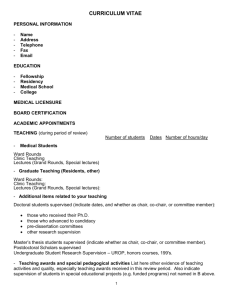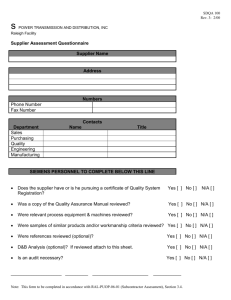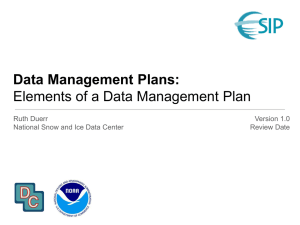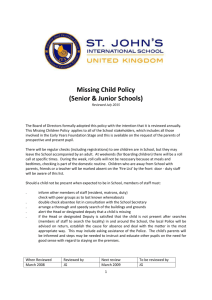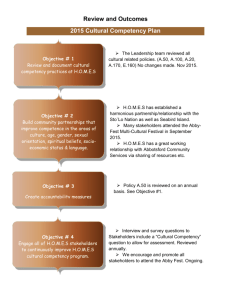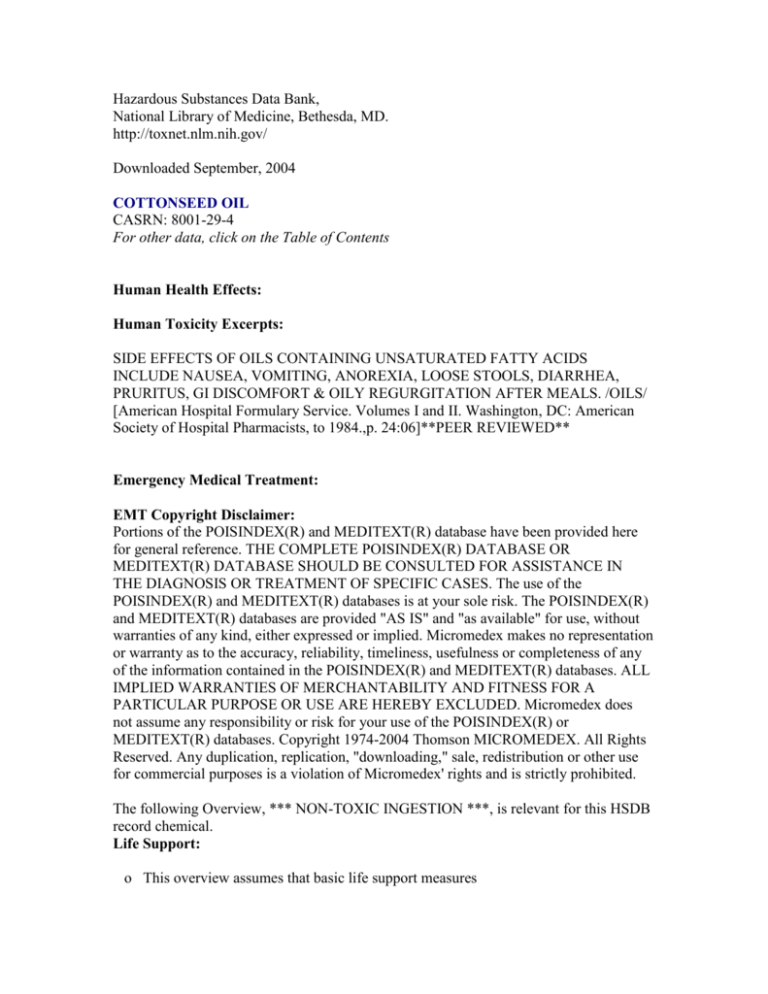
Hazardous Substances Data Bank,
National Library of Medicine, Bethesda, MD.
http://toxnet.nlm.nih.gov/
Downloaded September, 2004
COTTONSEED OIL
CASRN: 8001-29-4
For other data, click on the Table of Contents
Human Health Effects:
Human Toxicity Excerpts:
SIDE EFFECTS OF OILS CONTAINING UNSATURATED FATTY ACIDS
INCLUDE NAUSEA, VOMITING, ANOREXIA, LOOSE STOOLS, DIARRHEA,
PRURITUS, GI DISCOMFORT & OILY REGURGITATION AFTER MEALS. /OILS/
[American Hospital Formulary Service. Volumes I and II. Washington, DC: American
Society of Hospital Pharmacists, to 1984.,p. 24:06]**PEER REVIEWED**
Emergency Medical Treatment:
EMT Copyright Disclaimer:
Portions of the POISINDEX(R) and MEDITEXT(R) database have been provided here
for general reference. THE COMPLETE POISINDEX(R) DATABASE OR
MEDITEXT(R) DATABASE SHOULD BE CONSULTED FOR ASSISTANCE IN
THE DIAGNOSIS OR TREATMENT OF SPECIFIC CASES. The use of the
POISINDEX(R) and MEDITEXT(R) databases is at your sole risk. The POISINDEX(R)
and MEDITEXT(R) databases are provided "AS IS" and "as available" for use, without
warranties of any kind, either expressed or implied. Micromedex makes no representation
or warranty as to the accuracy, reliability, timeliness, usefulness or completeness of any
of the information contained in the POISINDEX(R) and MEDITEXT(R) databases. ALL
IMPLIED WARRANTIES OF MERCHANTABILITY AND FITNESS FOR A
PARTICULAR PURPOSE OR USE ARE HEREBY EXCLUDED. Micromedex does
not assume any responsibility or risk for your use of the POISINDEX(R) or
MEDITEXT(R) databases. Copyright 1974-2004 Thomson MICROMEDEX. All Rights
Reserved. Any duplication, replication, "downloading," sale, redistribution or other use
for commercial purposes is a violation of Micromedex' rights and is strictly prohibited.
The following Overview, *** NON-TOXIC INGESTION ***, is relevant for this HSDB
record chemical.
Life Support:
o This overview assumes that basic life support measures
have been instituted.
Clinical Effects:
0.2.1 SUMMARY OF EXPOSURE
0.2.1.1 ACUTE EXPOSURE
A) A non-toxic ingestion occurs when the victim consumes a
nonedible product which usually does not produce
symptoms. The importance of knowing that a product is
nontoxic is that overtreatment is avoided and, more
importantly, the victim and parents are not placed in
the jeopardy of a panicky automobile ride to the
physician or nearest hospital (Comstock, 1978).
B) Materials referenced to this management have been
considered very unlikely to produce any toxicity except
in enormous doses. For example, ballpoint pen
cartridges, even if sucked completely dry by a child,
do not contain enough toxic materials to cause illness
(Mofenson et al, 1984).
C) While almost anything, including water and table salt,
may cause illness if taken in excessive amounts or by
other than the normal route, normal exposures from
these products would not be expected to produce
toxicity (Horev & Cohen, 1994).
D) Some agents are harmful in manners different from that
expected. A broken thermometer is dangerous not from
the inert metallic mercury, but from the broken glass
(Mofenson et al, 1984). Most patients calling are more
worried about mercury, which they think of as poison,
than the glass.
E) General guidelines for determining if an exposure can
be categorized as non-toxic (reviewed in Weisman, 1998;
(Mofenson et al, 1984):
1) Absolute identification of the product, its
ingredients, and its concentration.
2) Absolute assurance that only the identified product
was involved in the exposure.
3) The exposure must be unintentional.
4) "Signal words" identified by the Consumer Product
Safety Commission (i.e. Caution, Warning, Danger) must
not be found on the label.
5) A reliable approximation of the quantity of the
substance involved in the exposure.
6) The route of exposure can be assessed accurately from
the patient's available history.
7) Following the exposure, the patient is symptom-free.
8) A follow-up consultation with the patient must be
possible. In the case of a pediatric exposure, the
parent must appear to be reliable.
Laboratory:
A) In most cases it will not be necessary to perform
laboratory tests. However, if a patient is developing
symptoms from what should be a non-toxic product,
appropriate evaluation and treatment should be performed.
Treatment Overview:
0.4.2 ORAL EXPOSURE
A) Even though a substance may be considered non-toxic for
the amount ingested or packaged, it should not be
considered as non-toxic in any amounts. Even ingestions
of various foodstuffs can cause adverse symptoms if
large amounts are eaten (green apples, garlic, onion).
B) The most important fact to remember is to treat the
patient not the poison, especially when the diagnosis is
unknown.
C) Knowing that the product is listed as non-toxic helps
avoid overtreating the patient or being over zealous in
getting a patient to professional medical care.
D) If there is a question of simultaneous ingestion of a
product which may be more dangerous, the management on
the more toxic agent should be consulted.
0.4.3 INHALATION EXPOSURE
A) Although inhalation of common dust may not be considered
toxic, it is certainly a hazard if there is inhalation
of too many particles. Individuals should be removed
from exposure to too high a concentration of even
relatively non-toxic substances.
0.4.4 EYE EXPOSURE
A) Foreign materials in the eye may not cause a toxic
reaction, but injury from a foreign body may occur. In
such cases, the patient should be observed for eye
irritation and should seek medical assistance if the
irritation becomes significant.
0.4.5 DERMAL EXPOSURE
A) OVERVIEW
1) Foreign materials spilled on the skin may not represent
a toxic or irritation hazard in small quantities, but
may produce adverse effects if applied in large
quantities or if used over a significant period of
time. Whenever possible, foreign materials should be
removed from the skin with simple washing. Should skin
irritation or erythema occur, a patient may wish to
seek medical assistance.
Range of Toxicity:
A) These agents are considered not to be a toxic hazard in
the quantities available through normal exposure or
package size.
ONIST
[Rumack BH POISINDEX(R) Information System Micromedex, Inc., Englewood, CO,
2004; CCIS Volume 122, edition expires Nov, 2004. Hall AH & Rumack BH (Eds):
TOMES(R) Information System Micromedex, Inc., Englewood, CO, 2004; CCIS Volume
122, edition expires Nov, 2004.]**PEER REVIEWED**
Animal Toxicity Studies:
Non-Human Toxicity Excerpts:
STUDY OF EXCERBATION OF HEART & LIVER LESIONS IN RATS BY
FEEDING OF MILDLY OXIDIZED FATS, INCLUDED COTTONSEED OIL.
[KAUNITZ H, JOHNSON RE; LIPIDS 8 (6): 329 (1973)]**PEER REVIEWED**
IN SPRAGUE DAWLEY RATS FED 30% LEVEL OF COTTONSEED OIL,
PARENTAL GENERATION WAS NOT SIGNIFICANTLY AFFECTED; HOWEVER,
THE F1 GENERATION HAD SIGNIFICANTLY ALTERED SEXUAL MATURITY,
& CHARACTER & LENGTH OF ESTRUS CYCLES WERE ALTERED WITH 20%
MORTALITY IN NEWBORN.
[SHEEHAN ET ET AL; FED PROC FED AM SOC EXP BIOL 26: 800 (1967)]**PEER
REVIEWED**
THE INCIDENCE OF SPONTANEOUS MAMMARY TUMORS IN C3H MICE AT 52
WK WAS HIGHER IN MICE FED RATIONS CONTAINING COTTONSEED OIL
THAN IN MICE FED COMPARABLE FATTY ACID COMPOSITION. THE FATTY
ACID COMPOSITION OF TISSUE LIPIDS FROM MICE FED THE COTTONSEED
OIL SHOWED CHANGES INDICATING THE PRESENCE OF CYCLOPROPENE
FATTY ACIDS HIGHER LEVELS OF SATURATES & LOWER
OLEATE/STEARATE & PALMITOLEATE/PALMITATE RATIOS. A POSSIBLE
ASSOCIATION BETWEEN THE DEVELOPMENT OF A SPONTANEOUS
MAMMARY TUMOR IN C3H MOUSE & THE PRESENCE OF CYCLOPROPENE
FATTY ACID IN THE COTTONSEED OIL IS INDICATED.
[TINSLEY IJ ET AL; LIPIDS 17 (2): 115 (1982)]**PEER REVIEWED**
Gossypol is a toxic factor indigenous to the cotton plant genus Gossypium. Concn of free
gossypol contained in feedstuffs such as whole cottonseed and cottonseed meals vary
considerably. Nonruminant animals are particularly sensitive to the toxic effects of
gossypol, whereas ruminants are somewhat more resistant. Signs of gossypol toxicosis in
nonruminants, preruminants, and ruminants are similar and include labored breathing,
dyspnea, decreased growth rate, and anorexia but are not pathognomonic. Postmortem
findings include generalized edema and congestion of lungs and liver, fluid filled thoracic
and peritoneal cavities, and degeneration of heart fibers. The antifertility effect observed
in many nonruminant species is overshadowed by toxic effects, particularly in females.
Gossypol seems to disrupt estrous cycles, pregnancy, and early embryo development in
females of all nonruminant species studied. Probable mechanisms include an endocrine
effect on the ovary as well as a cytotoxic effect on the uterus or embryo. The female
ruminant seems to be relatively insensitive to the antifertility effect of gossypol; however,
in vitro data indicate some inhibition of embryonic development and ovarian
steroidogenesis. The antifertility effect of gossypol has been studied most in males of
nonruminant species. The effects of gossypol in the male are both dose and time
dependent. At effective doses, gossypol causes males to be infertile because of sperm
immotility and depressed sperm counts. Specific mitochondrial damage in the tails of
spermatozoa seems to render them immotile, and extensive damage to germinal
epithelium may be responsible for depressions in spermatogenesis. In ruminant males fed
diets containing gossypol, ejaculated sperm appears normal under light microscopy. The
integrity of the membrane of sperm cells may be damaged. Extensive damage to the
germinal epithelium has been shown in both rams and bulls fed diets containing gossypol
and is of major concern.
[Randel RD et al; J Anim Sci 70 (5): 1628-38 (1992)]**PEER REVIEWED**
Metabolism/Pharmacokinetics:
Mechanism of Action:
TAKEN INTERNALLY, DIGESTIBLE OILS RETARD GASTRIC SECRETION AND
MOTILITY AND INCR THE CALORIC INTAKE.
[Osol, A. and J.E. Hoover, et al. (eds.). Remington's Pharmaceutical Sciences. 15th ed.
Easton, Pennsylvania: Mack Publishing Co., 1975. 1241]**PEER REVIEWED**
Interactions:
CYCLOPROPENOID FATTY ACID ORALLY ADMIN AS FOOD-GRADE
COTTONSEED OIL (0.35%) OR STERCULIA FOETIDA OIL (50%) EXHIBITED A
WEAK COCARCINOGENIC EFFECT, BUT GENERALLY DID NOT INFLUENCE
CARCINOGENICITY OF AFLATOXIN B1 OR DIETHYLNITROSAMINE IN
WISTAR & FISCHER RATS.
[NIXON JE ET AL; J NATL CANCER INST 53 (2): 453 (1974)]**PEER
REVIEWED**
CYCLOPROPENOID FATTY ACIDS, NATURALLY PRESENT IN COTTONSEED
OIL, ARE CARCINOGENS & EXHIBIT A POTENT SYNERGISTIC EFFECT ON
AFLATOXIN B1 HEPATOCARCINOGENESIS IN RAINBOW TROUT. THE
PREDOMINANT CPFA CYCLOPROPENOID FATTY ACID CONSTITUENTS OF
COTTONSEED OIL ARE MALVALIC & STERCULIC ACID.
[BAILEY ML ET AL; FED PROC 38(3, PART 1): 394 (1979)]**PEER REVIEWED**
MUCH GREATER INCIDENCE OF CANCER INDUCED BY KERNEL THAN BY
OIL INDICATES SYNERGISTS (AFLATOXINS) OR OTHER CARCINOGENS
PRESENT IN KERNEL IN ADDN TO CYCLOPROPENOID FATTY ACIDS.
[HENDRICKS JD ET AL; SCIENCE 208 (4441): 309 (1980)]**PEER REVIEWED**
FEMALE EVANS RATS, ON 100% PURINA LABORATORY CHOW DIETS FOR 20
MO, DEVELOPED 5 MAMMARY FIBROPLASIAS & 2 LYMPHOID TUMORS. A
GROUP ON 90% LABORATORY CHOW + 10% USP COTTONSEED OIL
DEVELOPED 3 MAMMARY FIBROPLASIAS, 5 LYMPHOID TUMORS, 1 BREAST
ADENOCARCINOMA & 2 SARCOMAS.
[BRYSON G, BISCHOFF F; PROC AM ASSOC CANCER RES 5 (1): 8
(1964)]**PEER REVIEWED**
Pharmacology:
Therapeutic Uses:
MEDICATION (VET): Peduculicide, acaricide, laxative, emollient.
[Budavari, S. (ed.). The Merck Index - Encyclopedia of Chemicals, Drugs and
Biologicals. Rahway, NJ: Merck and Co., Inc., 1989. 400]**QC REVIEWED**
TAKEN INTERNALLY, COTTONSEED OIL IS ... MILDLY LAXATIVE & IS
USEFUL IN MILD CASES OF CHRONIC CONSTIPATION ASSOCIATED WITH
MALNUTRITION.
[American Hospital Formulary Service. Volumes I and II. Washington, DC: American
Society of Hospital Pharmacists, to 1984.,p. 84:24]**PEER REVIEWED**
/OIL/ ... APPEARS TO BE EQUALLY EFFECTIVE IN REDUCING SERUM
CHOLESTEROL LEVELS WHEN USED IN PLACE OF SATURATED FATS IN
WELL MODERATED DIET.
[American Hospital Formulary Service. Volumes I and II. Washington, DC: American
Society of Hospital Pharmacists, to 1984.,p. 24:06]**PEER REVIEWED**
Interactions:
CYCLOPROPENOID FATTY ACID ORALLY ADMIN AS FOOD-GRADE
COTTONSEED OIL (0.35%) OR STERCULIA FOETIDA OIL (50%) EXHIBITED A
WEAK COCARCINOGENIC EFFECT, BUT GENERALLY DID NOT INFLUENCE
CARCINOGENICITY OF AFLATOXIN B1 OR DIETHYLNITROSAMINE IN
WISTAR & FISCHER RATS.
[NIXON JE ET AL; J NATL CANCER INST 53 (2): 453 (1974)]**PEER
REVIEWED**
CYCLOPROPENOID FATTY ACIDS, NATURALLY PRESENT IN COTTONSEED
OIL, ARE CARCINOGENS & EXHIBIT A POTENT SYNERGISTIC EFFECT ON
AFLATOXIN B1 HEPATOCARCINOGENESIS IN RAINBOW TROUT. THE
PREDOMINANT CPFA CYCLOPROPENOID FATTY ACID CONSTITUENTS OF
COTTONSEED OIL ARE MALVALIC & STERCULIC ACID.
[BAILEY ML ET AL; FED PROC 38(3, PART 1): 394 (1979)]**PEER REVIEWED**
MUCH GREATER INCIDENCE OF CANCER INDUCED BY KERNEL THAN BY
OIL INDICATES SYNERGISTS (AFLATOXINS) OR OTHER CARCINOGENS
PRESENT IN KERNEL IN ADDN TO CYCLOPROPENOID FATTY ACIDS.
[HENDRICKS JD ET AL; SCIENCE 208 (4441): 309 (1980)]**PEER REVIEWED**
FEMALE EVANS RATS, ON 100% PURINA LABORATORY CHOW DIETS FOR 20
MO, DEVELOPED 5 MAMMARY FIBROPLASIAS & 2 LYMPHOID TUMORS. A
GROUP ON 90% LABORATORY CHOW + 10% USP COTTONSEED OIL
DEVELOPED 3 MAMMARY FIBROPLASIAS, 5 LYMPHOID TUMORS, 1 BREAST
ADENOCARCINOMA & 2 SARCOMAS.
[BRYSON G, BISCHOFF F; PROC AM ASSOC CANCER RES 5 (1): 8
(1964)]**PEER REVIEWED**
Environmental Fate & Exposure:
Natural Pollution Sources:
/IT IS/ FIXED OIL FROM SEEDS OF CULTIVATED VARIETIES OF GOSSYPIUM
HERBACEUM L & OF OTHER SPECIES OF GOSSYPIUM.
[Budavari, S. (ed.). The Merck Index - Encyclopedia of Chemicals, Drugs and
Biologicals. Rahway, NJ: Merck and Co., Inc., 1989. 400]**PEER REVIEWED**
Environmental Standards & Regulations:
FIFRA Requirements:
Cottonseed oil is exempted from the requirement of a tolerance when used as a safener
in accordance with good agricultural practice as inert (or occasionally active) ingredients
in pesticide formulations applied to animals.
[40 CFR 180.1001(e) (7/1/91)]**PEER REVIEWED**
Allowable Tolerances:
Cottonseed oil is exempted from the requirement of a tolerance when used as a safener
in accordance with good agricultural practice as inert (or occasionally active) ingredients
in pesticide formulations applied to animals.
[40 CFR 180.1001(e) (7/1/91)]**PEER REVIEWED**
Chemical/Physical Properties:
Molecular Formula:
UNKNOWN
**PEER REVIEWED**
Color/Form:
PALE YELLOW, OILY LIQUID /SRP: REFINED/
[Budavari, S. (ed.). The Merck Index - Encyclopedia of Chemicals, Drugs and
Biologicals. Rahway, NJ: Merck and Co., Inc., 1989. 400]**PEER REVIEWED**
YELLOWISH-BROWN TO DARK RUBY-RED OR BLACK-RED, FIXED, SEMIDRYING OIL DEPENDING ON THE NATURE & CONDITION OF THE SEED /SRP:
UNREFINED/
[Lewis, R.J., Sr (Ed.). Hawley's Condensed Chemical Dictionary. 12th ed. New York,
NY: Van Nostrand Rheinhold Co., 1993 319]**PEER REVIEWED**
Odor:
PRACTICALLY ODORLESS
[Budavari, S. (ed.). The Merck Index - Encyclopedia of Chemicals, Drugs and
Biologicals. Rahway, NJ: Merck and Co., Inc., 1989. 400]**PEER REVIEWED**
Taste:
BLAND TASTE
[Osol, A. and J.E. Hoover, et al. (eds.). Remington's Pharmaceutical Sciences. 15th ed.
Easton, Pennsylvania: Mack Publishing Co., 1975. 1241]**PEER REVIEWED**
Melting Point:
FP: 32 DEG F= 0 DEG C= 273 DEG K
[U.S. Coast Guard, Department of Transportation. CHRIS - Hazardous Chemical Data.
Manual Two. Washington, DC: U.S. Government Printing Office, Oct., 1978.]**PEER
REVIEWED**
Density/Specific Gravity:
0.915-0.921 @ 25 DEG/25 DEG C
[Budavari, S. (ed.). The Merck Index - Encyclopedia of Chemicals, Drugs and
Biologicals. Rahway, NJ: Merck and Co., Inc., 1989. 400]**PEER REVIEWED**
Heat of Combustion:
-16,000 BTU/LB= -8,870 CAL/G= -371X10+5 JOULES/KG
[U.S. Coast Guard, Department of Transportation. CHRIS - Hazardous Chemical Data.
Manual Two. Washington, DC: U.S. Government Printing Office, Oct., 1978.]**PEER
REVIEWED**
Solubilities:
SLIGHTLY SOL IN ALCOHOL; MISCIBLE WITH CHLOROFORM, ETHER,
CARBON DISULFIDE, PETROLEUM ETHER
[Budavari, S. (ed.). The Merck Index - Encyclopedia of Chemicals, Drugs and
Biologicals. Rahway, NJ: Merck and Co., Inc., 1989. 400]**PEER REVIEWED**
MISCIBLE WITH HEXANE
[Osol, A. and J.E. Hoover, et al. (eds.). Remington's Pharmaceutical Sciences. 15th ed.
Easton, Pennsylvania: Mack Publishing Co., 1975. 1241]**PEER REVIEWED**
SOL IN BENZENE
[Lewis, R.J., Sr (Ed.). Hawley's Condensed Chemical Dictionary. 12th ed. New York,
NY: Van Nostrand Rheinhold Co., 1993 319]**PEER REVIEWED**
Spectral Properties:
INDEX OF REFRACTION: 1.4645-1.4655 @ 40 DEG C/D
[Budavari, S. (ed.). The Merck Index - Encyclopedia of Chemicals, Drugs and
Biologicals. Rahway, NJ: Merck and Co., Inc., 1989. 400]**PEER REVIEWED**
Surface Tension:
35.4 DYNES/CM @ 20 DEG C; 31.3 DYNES/CM @ 80 DEG C
[Budavari, S. (ed.). The Merck Index - Encyclopedia of Chemicals, Drugs and
Biologicals. Rahway, NJ: Merck and Co., Inc., 1989. 400]**PEER REVIEWED**
Other Chemical/Physical Properties:
LIQUID-WATER INTERFACIAL TENSION: 50 DYNES/CM= 0.05 N/M @ 20 DEG C
[U.S. Coast Guard, Department of Transportation. CHRIS - Hazardous Chemical Data.
Manual Two. Washington, DC: U.S. Government Printing Office, Oct., 1978.]**PEER
REVIEWED**
PARTICLES OF SOLID FAT MAY SEPARATE BELOW 10 DEG C & OIL
SOLIDIFIES AT ABOUT 0 TO -5 DEG C
[Osol, A. and J.E. Hoover, et al. (eds.). Remington's Pharmaceutical Sciences. 15th ed.
Easton, Pennsylvania: Mack Publishing Co., 1975. 1241]**PEER REVIEWED**
SAPONIFICATION NUMBER: 190-198; IODINE NUMBER: 105-114
[Budavari, S. (ed.). The Merck Index - Encyclopedia of Chemicals, Drugs and
Biologicals. Rahway, NJ: Merck and Co., Inc., 1989. 400]**PEER REVIEWED**
Solidifies 0 to -5 deg C
[Budavari, S. (ed.). The Merck Index - Encyclopedia of Chemicals, Drugs and
Biologicals. Rahway, NJ: Merck and Co., Inc., 1989. 400]**PEER REVIEWED**
/Fatty Acid Composition/ 0.5% myristic, 21% palmitic, 2% stearic, 29% oleic, 45%
linoleic, 2% linolenic
[Kirk-Othmer Encyclopedia of Chemical Technology. 3rd ed., Volumes 1-26. New York,
NY: John Wiley and Sons, 1978-1984.,p. V4 848 (1978)]**PEER REVIEWED**
Chemical Safety & Handling:
Fire Potential:
SLIGHT, WHEN EXPOSED TO HEAT OR FLAME. HOWEVER, IF ALLOWED TO
IMPREGNATE RAGS OR OILY WASTE, IT CAN BE A DANGEROUS HAZARD. ...
SPONTANEOUS HEATING: MODERATE. /DEODORIZED WINTERIZED
COTTONSEED OIL/
[Sax, N.I. Dangerous Properties of Industrial Materials. 6th ed. New York, NY: Van
Nostrand Reinhold, 1984. 811]**PEER REVIEWED**
NFPA Hazard Classification:
Health: 0. 0= Materials that, on exposure under fire conditions, offer no hazard beyond
that of ordinary combustible material.
[Fire Protection Guide to Hazardous Materials. 12 ed. Quincy, MA: National Fire
Protection Association, 1997. ,p. 325-28]**QC REVIEWED**
Flammability: 1. 1= This degree includes materials that must be preheated before ignition
will occur, such as Class IIIB combustible liquids and solids and semi-solids whose flash
point exceeds 200 deg F (93.4 deg C), as well as most ordinary combustible materials.
Water may cause frothing if it sinks below the surface of the burning liquid and turns to
steam. However, a water fog that is gently applied to the surface of the liquid will cause
frothing that will extinguish the fire.
[Fire Protection Guide to Hazardous Materials. 12 ed. Quincy, MA: National Fire
Protection Association, 1997. ,p. 325-28]**QC REVIEWED**
Reactivity: 0. 0= This degree includes materials that are normally stable, even under fire
exposure conditions, and that do not react with water. Normal fire fighting procedures
may be used.
[Fire Protection Guide to Hazardous Materials. 12 ed. Quincy, MA: National Fire
Protection Association, 1997. ,p. 325-28]**QC REVIEWED**
Flash Point:
486 deg F (252 deg C) (Open cup) /Cottonseed oil refined/
[Fire Protection Guide to Hazardous Materials. 12 ed. Quincy, MA: National Fire
Protection Association, 1997. ,p. 325-28]**QC REVIEWED**
610 deg F (321 deg C) (Open cup) /Cottonseed oil, cooking/
[Fire Protection Guide to Hazardous Materials. 12 ed. Quincy, MA: National Fire
Protection Association, 1997. ,p. 325-28]**QC REVIEWED**
Autoignition Temperature:
650 DEG F (343 ded C)/REFINED OIL/
[Fire Protection Guide to Hazardous Materials. 12 ed. Quincy, MA: National Fire
Protection Association, 1997. ,p. 325-28]**QC REVIEWED**
Fire Fighting Procedures:
DRY CHEMICAL, FOAM, OR CARBON DIOXIDE. WATER OR FOAM MAY
CAUSE FROTHING.
[U.S. Coast Guard, Department of Transportation. CHRIS - Hazardous Chemical Data.
Manual Two. Washington, DC: U.S. Government Printing Office, Oct., 1978.]**PEER
REVIEWED**
Explosive Limits & Potential:
Combustible
[Lewis, R.J., Sr (Ed.). Hawley's Condensed Chemical Dictionary. 12th ed. New York,
NY: Van Nostrand Rheinhold Co., 1993 319]**PEER REVIEWED**
Occupational Exposure Standards:
Manufacturing/Use Information:
Major Uses:
MFR SOAPS, OLEO MARGARINE, HYDROGENATED FATS, LARD
SUBSTITUTE, GLYCEROL, LEATHER DRESSINGS, LUBRICANTS, COSMETICS;
PACKING FISH; PHARMACEUTIC AID (SOLVENT); EMOLLIENT; ALSO AS
SALAD AND COOKING OIL
[Budavari, S. (ed.). The Merck Index - Encyclopedia of Chemicals, Drugs and
Biologicals. Rahway, NJ: Merck and Co., Inc., 1989. 400]**QC REVIEWED**
COMPONENT OF EDIBLE OILS, MARGARINE, & SHORTENING; CHEM INT
FOR LUBRICANTS, GREASES, PAINTS, VARNISHES, FATTY ACIDS, & SOAPS
[SRI]**PEER REVIEWED**
HYDROGENATED TO SEMISOLID FOR USE IN FOOD PRODUCTS;
WATERPROOFING COMPOSITIONS; DIETARY SUPPLEMENT.
[Lewis, R.J., Sr (Ed.). Hawley's Condensed Chemical Dictionary. 12th ed. New York,
NY: Van Nostrand Rheinhold Co., 1993 319]**PEER REVIEWED**
MEDICATION
**QC REVIEWED**
MEDICATION (VET)
**QC REVIEWED**
Methods of Manufacturing:
/COTTONSEED OIL IS/ MADE IN SOUTHERN PART OF US ON A VERY LARGE
SCALE WHERE COTTON IS GROWN. SEEDS CONTAIN ABOUT 15% OIL.
TESTAE OF SEEDS ARE FIRST SEPARATED & KERNELS ARE ... /PRESSED/ IN
HYDRAULIC PRESSES. ... IT REQUIRES PURIFICATION BEFORE ... /BEING
USED/ FOR MEDICINAL OR FOOD PURPOSES.
[Osol, A. and J.E. Hoover, et al. (eds.). Remington's Pharmaceutical Sciences. 15th ed.
Easton, Pennsylvania: Mack Publishing Co., 1975. 1241]**PEER REVIEWED**
FROM COTTON SEEDS BY ... SOLVENT EXTRACTION.
[Lewis, R.J., Sr (Ed.). Hawley's Condensed Chemical Dictionary. 12th ed. New York,
NY: Van Nostrand Rheinhold Co., 1993 319]**PEER REVIEWED**
General Manufacturing Information:
CYCLOPROPENOID FATTY ACIDS (CPFA), NATURALLY PRESENT IN
COTTONSEED OIL, ARE CARCINOGENS & EXHIBIT A POTENT SYNERGISTIC
EFFECT ON AFLATOXIN B1 HEPATOCARCINOGENESIS IN RAINBOW TROUT.
THE PREDOMINANT CPFA CONSTITUENTS OF COTTONSEED OIL ARE
MALVALIC & STERCULIC ACID.
[BAILEY ML ET AL; FED PROC 38 (3 PART 1): 394 (1979)]**PEER REVIEWED**
THE CONCN OF 13 POLYCYCLIC AROMATIC HYDROCARBONS WAS
DETERMINED IN 64 CRUDE SAMPLES OF 9 VEGETABLE OILS. COTTONSEED
AND LINSEED OILS HAD VERY LOW LEVELS OF 3,4-BENZO(A)PYRENE (1.42.8 UG/KG) & OTHER CARCINOGENS.
[GRIMMER G; ARCH HYG BAKTERIOL 152 (3): 255 (1968)]**PEER
REVIEWED**
CHIEF CONSTITUENTS: GLYCERIDES OF PALMITIC, OLEIC & LINOLEIC
ACIDS.
[Lewis, R.J., Sr (Ed.). Hawley's Condensed Chemical Dictionary. 12th ed. New York,
NY: Van Nostrand Rheinhold Co., 1993 319]**PEER REVIEWED**
Formulations/Preparations:
A 15% OIL IN WATER EMULSION OF REFINED FIXED OIL ... .
[Osol, A. and J.E. Hoover, et al. (eds.). Remington's Pharmaceutical Sciences. 15th ed.
Easton, Pennsylvania: Mack Publishing Co., 1975. 965]**PEER REVIEWED**
COTTONSEED OIL (DEODORIZED WINTERIZED), NCI-C50168. /DEODORIZED
WINTERIZED COTTONSEED OIL/
[U.S. Department of Health and Human Services, Public Health Service, Center for
Disease Control, National Institute for Occupational Safety Health. Registry of Toxic
Effects of Chemical Substances (RTECS). National Library of Medicine's current
MEDLARS file.p. 82/8105]**PEER REVIEWED**
METHOD & COMPOSITION OF 6 KG LOT WAS:COTTONSEED OIL 900 G
(15.0%, WT/WT), PURIFIED SOYBEAN LETHICIN 72 G (1.2%), PLURONIC F-68
18 G (0.3%), DMBA 30 G (0.5%), & WATER FOR INJECTION 4980 G (83.0%).
[SCHURR PE; CANCER RES 29 (1): 258 (1969)]**PEER REVIEWED**
GRADES: CRUDE ... PRIME SUMMER YELLOW, BLEACHABLE, UNITED
STATES PHARMACOPEIA.
[Lewis, R.J., Sr (Ed.). Hawley's Condensed Chemical Dictionary. 12th ed. New York,
NY: Van Nostrand Rheinhold Co., 1993 319]**PEER REVIEWED**
GRADES: REFINED, COOKING.
[U.S. Coast Guard, Department of Transportation. CHRIS - Hazardous Chemical Data.
Manual Two. Washington, DC: U.S. Government Printing Office, Oct., 1978.]**PEER
REVIEWED**
/Fatty Acid Composition/ 0.5% myristic, 21% palmitic, 2% stearic, 29% oleic, 45%
linoleic, 2% linolenic
[Kirk-Othmer Encyclopedia of Chemical Technology. 3rd ed., Volumes 1-26. New York,
NY: John Wiley and Sons, 1978-1984.,p. V4 848 (1978)]**PEER REVIEWED**
Impurities:
The pigmentation of crude cottonseed /oil/ is due to the presence of high levelsof
gossypol.
[Kirk-Othmer Encyclopedia of Chemical Technology. 3rd ed., Volumes 1-26. New York,
NY: John Wiley and Sons, 1978-1984.,p. V23 720 (1983)]**PEER REVIEWED**
0.7-0.9% Phosphatides, 0.5-0.8% total unsaponifiable matter, 0.26-0.31% sterols, 10001200 ppm tocopherols
[Kirk-Othmer Encyclopedia of Chemical Technology. 3rd ed., Volumes 1-26. New York,
NY: John Wiley and Sons, 1978-1984.,p. V23 720 (1983)]**PEER REVIEWED**
Consumption Patterns:
64% IN SALAD & COOKING OIL; 22% IN SHORTENING; 7% IN MARGARINE;
6% IN OTHER EDIBLE USES; 1% AS A CHEM INT FOR LUBRICANTS,
GREASES, PAINTS, VARNISHES, FATTY ACIDS, & SOAPS (1974)
[SRI]**PEER REVIEWED**
U. S. Production:
(1972) 6.15X10+11 GRAMS
[SRI]**PEER REVIEWED**
(1974) 6.88X10+11 GRAMS
[SRI]**PEER REVIEWED**
3.65X10+11 g
[BUREAU OF THE CENSUS. CURRENT INDUSTRIAL REPORTS: FATS AND
OILS-OILSEED CRUSHINGS 1985 p.1 (1984)]**PEER REVIEWED**
U. S. Imports:
(1972) NEGLIGIBLE
[SRI]**PEER REVIEWED**
U. S. Exports:
(1972) 2.13X10+11 GRAMS
[SRI]**PEER REVIEWED**
(1974) 2.75X10+11 GRAMS
[SRI]**PEER REVIEWED**
(1984) 1.69X10+11g /crude, once-refined and salad oil/
[BUREAU OF THE CENSUS. U.S. EXPORTS, SCHEDULE E, p.2-68(1984)]**PEER
REVIEWED**
Laboratory Methods:
Analytic Laboratory Methods:
THE FATTY ACID COMPOSITION OF 20 COTTONSEED OILS WAS
DETERMINED BY ISOTHERMAL GLC ANALYSIS OF TOTAL ESTERS. CRUDE
& REFINED OILS DID NOT DIFFER MARKEDLY IN THEIR FATTY ACID
COMPOSITION. MALVALIC & STERCULIC ACIDS WERE PRESENT.
[IVERSON JL; J ASSOC OFFIC ANAL CHEMISTS 52 (NOV): 1148 (1969)]**PEER
REVIEWED**
DETERMINATION OF OIL (COTTONSEED) IN OILS AND FATS BY USING
HALPHEN TEST. ALSO DETERMINATION OF OIL IN COTTONSEED BY USING
MODIFIED BELLIER TEST, IF TURBIDITY APPEARS BEFORE TEMP REACHES
13 DEG C (COTTONSEED) PRESENCE OF PEANUT OIL IS INDICATED.
[Association of Official Analytical Chemists. Official Methods of Analysis. 15th ed. and
Supplements. Washington, DC: Association of Analytical Chemists, 1990,p. V2 9778]**PEER REVIEWED**
Special References:
Synonyms and Identifiers:
Synonyms:
COTTON OIL
**PEER REVIEWED**
Formulations/Preparations:
A 15% OIL IN WATER EMULSION OF REFINED FIXED OIL ... .
[Osol, A. and J.E. Hoover, et al. (eds.). Remington's Pharmaceutical Sciences. 15th ed.
Easton, Pennsylvania: Mack Publishing Co., 1975. 965]**PEER REVIEWED**
COTTONSEED OIL (DEODORIZED WINTERIZED), NCI-C50168. /DEODORIZED
WINTERIZED COTTONSEED OIL/
[U.S. Department of Health and Human Services, Public Health Service, Center for
Disease Control, National Institute for Occupational Safety Health. Registry of Toxic
Effects of Chemical Substances (RTECS). National Library of Medicine's current
MEDLARS file.p. 82/8105]**PEER REVIEWED**
METHOD & COMPOSITION OF 6 KG LOT WAS:COTTONSEED OIL 900 G
(15.0%, WT/WT), PURIFIED SOYBEAN LETHICIN 72 G (1.2%), PLURONIC F-68
18 G (0.3%), DMBA 30 G (0.5%), & WATER FOR INJECTION 4980 G (83.0%).
[SCHURR PE; CANCER RES 29 (1): 258 (1969)]**PEER REVIEWED**
GRADES: CRUDE ... PRIME SUMMER YELLOW, BLEACHABLE, UNITED
STATES PHARMACOPEIA.
[Lewis, R.J., Sr (Ed.). Hawley's Condensed Chemical Dictionary. 12th ed. New York,
NY: Van Nostrand Rheinhold Co., 1993 319]**PEER REVIEWED**
GRADES: REFINED, COOKING.
[U.S. Coast Guard, Department of Transportation. CHRIS - Hazardous Chemical Data.
Manual Two. Washington, DC: U.S. Government Printing Office, Oct., 1978.]**PEER
REVIEWED**
/Fatty Acid Composition/ 0.5% myristic, 21% palmitic, 2% stearic, 29% oleic, 45%
linoleic, 2% linolenic
[Kirk-Othmer Encyclopedia of Chemical Technology. 3rd ed., Volumes 1-26. New York,
NY: John Wiley and Sons, 1978-1984.,p. V4 848 (1978)]**PEER REVIEWED**
Administrative Information:
Hazardous Substances Databank Number: 913
Last Revision Date: 20030305
Last Review Date: Reviewed by SRP on 12/10/1993
Update History:
Complete Update on 03/05/2003, 5 fields added/edited/deleted.
Field Update on 05/13/2002, 1 field added/edited/deleted.
Field Update on 05/15/2001, 1 field added/edited/deleted.
Complete Update on 08/26/1999, 1 field added/edited/deleted.
Complete Update on 10/20/1997, 1 field added/edited/deleted.
Complete Update on 04/07/1997, 2 fields added/edited/deleted.
Complete Update on 03/12/1997, 2 fields added/edited/deleted.
Complete Update on 10/13/1996, 1 field added/edited/deleted.
Complete Update on 01/19/1996, 1 field added/edited/deleted.
Complete Update on 04/20/1995, 1 field added/edited/deleted.
Complete Update on 04/20/1995, 1 field added/edited/deleted.
Complete Update on 12/22/1994, 1 field added/edited/deleted.
Complete Update on 04/16/1994, 36 fields added/edited/deleted.
Field Update on 03/21/1994, 1 field added/edited/deleted.
Field update on 12/16/1992, 1 field added/edited/deleted.
Field update on 12/29/1989, 1 field added/edited/deleted.
Complete Update on 10/14/1986

